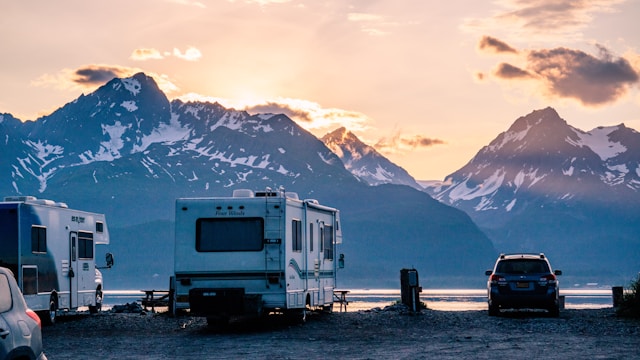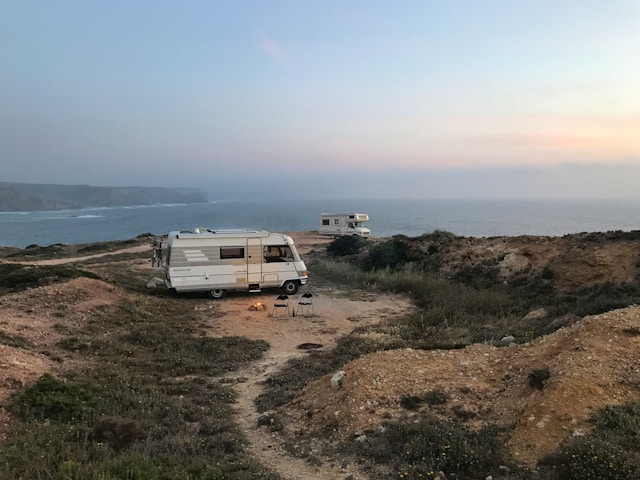
Saving Money While Traveling Across the Country in Your RV: Top Budget Tips
cannon
- 0
Traveling across the country in an RV offers a unique sense of freedom and adventure. However, the costs can add up quickly if not managed wisely. Savvy travelers know that with a little planning and some smart choices, it’s possible to significantly reduce expenses without detracting from the experience. By prioritizing and recognizing where savings can be made, they can enjoy the journey as much as the destinations along the way.
Cost-cutting strategies range from how they plan their route to where they choose to stay each night. Employing methods like seasonal camp hosting not only alleviates campground fees but can also add to the overall travel experience by allowing travelers to stay in one location longer and get to know the community. Other approaches include making the RV more energy-efficient, such as by harnessing solar power, which can lead to considerable savings on utilities.
Moreover, travelers can curb their spending by being mindful of daily living expenses. Simple actions like preparing meals in the RV rather than dining out and getting crafty with DIY repairs can preserve their travel budget. By staying informed about the costs associated with RV travel, adventurers can anticipate expenses and make more economical choices without missing out on what full-time RV living has to offer.
Planning Your Route
When embarking on an RV journey across America, strategic route planning can lead to substantial savings. Travelers should focus on selecting the most cost-effective paths and using modern mapping technology to streamline their travel plans.
Selecting Cost-Effective Routes
Travelers can save money by choosing routes that avoid toll roads and high-traffic areas which could lead to increased fuel consumption. Opting to drive through scenic byways or state routes can also provide significant savings. For instance, planning a route that includes camping at state parks with full hookups is more economical, as these can cost up to $50.00 per night, compared to over $100.00 at luxury resorts.
Utilizing Mapping Apps for Efficiency
Modern mapping apps are invaluable tools for efficient RV travel. They allow users to plot their trip, assess traffic conditions in real-time, and even locate the best fuel prices. One prominent app recommended by Cruise America helps in planning an RV trip across the country by suggesting the route with the most efficient use of time and fuel. This type of app usually offers the option to include points of interest along the way, ensuring travelers don’t miss any must-see destinations.
Budgeting for Your Trip
Careful planning and budget allocation are fundamentals for a cost-effective journey in an RV. A traveler must consider daily expenses, accommodation costs at campsites, and the significant portion of the budget that will go towards fuel.
Calculating Daily Expenses
Travelers should tally up daily living costs, including food, entertainment, and miscellaneous items. A realistic daily budget may look something like this:
- Food: $15-30 per day
- Entertainment: $10-20 per day
- Miscellaneous: $5-15 per day
These numbers can fluctuate based on personal habits and the trip’s location. They serve as a base to estimate daily spending.
Allocating Funds for Campsites
Camping fees vary widely based on location, amenities, and time of year. Research is crucial to estimate these costs accurately. A rough breakdown is as follows:
- Standard Campsites: $20-40 per night
- Campgrounds with Amenities (pools, WiFi): $45-70 per night
- Luxury RV Parks: $75-150 per night
Many RVers save money by using a mix of different types of campsites or opting for free camping options where available.
Anticipating Fuel Costs
Fuel is one of the largest expenses for RV travel. The average RV can get between 6-12 miles per gallon, and with gas prices constantly changing, this cost can fluctuate. At a median price of $3.00 per gallon, driving 300 miles would cost about:
- 6 mpg: $150
- 10 mpg: $90
- 12 mpg: $75
It’s advisable for travelers to monitor fuel prices across states to budget accordingly, as cross-country travel can lead to crossing regions with varying fuel rates.
Choosing the Right RV
Making the appropriate choice of an RV is critical when embarking on a cross-country adventure, as it directly impacts your travel expenses and comfort.
Assessing RV Types and Fuel Economy
When travelers consider various RV types, they must evaluate the size and amenities against their fuel economy. Class A motorhomes, though spacious and luxurious, are typically the least fuel-efficient, with miles per gallon (MPG) often in the single digits. On the other hand, Class B motorhomes and campervans offer better fuel efficiency, frequently reaching between 18-25 MPG due to their smaller size.
Class C motorhomes strike a balance with moderate living space and decent fuel economy, often getting between 10-18 MPG. Evaluating your travel needs against these options is essential to managing long-term travel costs. To potentially save money and still get an excellent camper that suits your needs, a travel trailer might be a prudent choice.
Considering the Cost of RV Rental vs. Purchase
Travelers must also deliberate the costs of RV rental versus purchase. Renting can be a practical choice for those planning a one-time trip, with daily rates varying significantly depending on the model and rental period. Purchasing an RV, while initially more expensive, can be cost-effective for those planning frequent or long-term travels.
Ownership allows individuals to build equity in their vehicle and potentially save over time, especially if they opt for used models. Nonetheless, RV ownership brings additional expenses such as maintenance, storage, insurance, and depreciation, which must be weighed against rental expense.
Selecting the correct RV type and deciding whether to rent or buy are pivotal decisions that directly influence the financial feasibility of a cross-country RV trip.
Camping and Overnight Parking
Travelers can significantly cut costs on a country-wide RV trip by exploring free or low-cost overnight parking options, with large retailers offering alternatives to traditional campsites.
Finding Free or Low-Cost Campsites
Camping expenses can quickly add up, but travelers can take advantage of a variety of sources for free or low-cost campsites. Public lands such as national forests and Bureau of Land Management areas offer spots known as boondocking sites, which are typically free of charge and allow for a truly rustic camping experience. For both safety and environmental reasons, visitors should always follow the Leave No Trace principles, such as packing out all waste and limiting stays to 14 days. Additionally, many smaller towns have municipal parks with low-cost camping options, some of which include hookups for a fraction of the price of private RV parks.
Walmart and Other Retailer Parking
Certain retailers have become popular among RV travelers for providing free overnight parking. Historically, Walmart has been known for being RV-friendly, although policies can vary by location and it is always best to call ahead. Other retailers may also allow overnight parking, including stores like Cracker Barrel and Cabela’s, where RVers can rest for the night. When parking at retail locations, customers should park in designated areas, keep a low profile, and patronize the establishment as a courtesy. Some Planet Fitness locations, when holding a membership, provide another unconventional yet practical overnight parking option, with the added benefit of access to gym facilities.
Food and Meals
When traveling across the country in an RV, managing food budgets wisely can make a significant difference. One can save substantially by meal planning and eating out selectively.
Meal Planning and Preparation
Eating cheaply while traveling doesn’t mean sacrificing quality. RV travelers can optimize their food budget by buying in bulk and preparing meals themselves. For instance, buying a large bag of rice or pasta can provide a base for multiple meals. Pair these staples with different proteins like chicken, beans, or eggs to create varied and satisfying dishes. One can also pack non-perishable snacks, such as nuts and dried fruit, reducing the need to purchase expensive snacks on the road.
Saving on Dining Out
Although cooking in the RV is cost-effective, occasionally one may want to enjoy local cuisine. To save on dining out, travelers can look for early-bird specials or dine at restaurants where kids eat for free if they’re traveling with children. Another strategy is to have a big meal out at lunch rather than dinner, as many restaurants offer lunch menus that are more affordable than the dinner selections. Utilizing a rewards credit card specifically for dining purchases can also lead to savings. Moreover, embracing local street food can be a delightful and budget-friendly way to taste regional flavors.
Saving on Entertainment
Traveling across the country in an RV doesn’t mean you’ll be spending a fortune on entertainment. There are copious opportunities to enjoy yourself without straining your wallet, mainly by focusing on natural attractions and taking advantage of available discounts.
Leveraging Free Natural Attractions
Explorers can utilize America’s vast natural landscapes for entertainment. Hiking trails, beaches, and public forests often provide free access to awe-inspiring vistas and outdoor activities. One can swim in a lake, hike to a scenic overlook, or even enjoy wildlife spotting—all without spending a dime. Nature itself is an RV traveler’s playground, offering endless opportunities for adventure at no cost.
Discounts for National Parks and Monuments
Travelers should consider securing an America the Beautiful – National Parks & Federal Recreational Lands Pass, which grants access to more than 2,000 federal recreation sites, including national parks and monuments. For a reasonable annual fee, this pass allows a vehicle’s passengers entry, making it an economically sound investment for those planning to visit multiple sites. Senior citizens, military members, and 4th-grade students often qualify for additional discounts or even free passes, enhancing the value proposition for these groups.
Fuel Savings
When traversing the country in an RV, managing fuel costs is critical. This section focuses on two proven strategies: participating in fuel rewards programs and employing driving techniques to enhance fuel economy.
Enrolling in Fuel Rewards Programs
Fuel rewards programs are a must for RV travelers looking to save on gas expenses. For instance, the Good Sam Club offers valuable discounts on fuel, with savings of $0.05 per gallon on gas and $0.10 per gallon on diesel at participating locations. Additionally, signing up for programs like Open Roads can result in savings at major gas stations.
Driving Strategies to Improve Fuel Efficiency
Driving habits have a substantial impact on fuel consumption. For example, maintaining a consistent speed and avoiding rapid acceleration can lead to improved gas mileage. Moreover, being mindful of the RV’s air conditioning use can lower fuel expenses, as running the A/C less frequently minimizes engine strain and, consequently, fuel usage.
Maintenance and Repairs
When it comes to RV travel, unforeseen repairs and maintenance can be one of the biggest expenses. Careful planning and a proactive approach to maintenance can help control these costs significantly.
Performing Regular DIY Maintenance
A traveler can save a considerable amount of money by performing regular DIY maintenance on their RV. Basic tasks like checking tire pressure, changing the oil, and inspecting seals can prevent costly issues down the road. Digital resources offer a wealth of knowledge for those looking to learn more about DIY RV maintenance. It’s essential to create a routine maintenance checklist to ensure all parts of the RV are in proper working order.
Identifying Affordable Service Providers
For maintenance needs beyond one’s DIY capabilities, identifying affordable service providers is key. Research is crucial; seeking out reputable mechanics with reasonable rates can make a significant difference in overall travel costs. Some travelers may find that smaller towns offer more competitive pricing compared to larger cities. Utilizing online forums and community insights can help locate service providers that offer quality at a lower cost.
Insurance and Roadside Assistance
When traversing the country in an RV, securing both comprehensive insurance and a reliable roadside assistance plan is crucial for peace of mind and cost efficiency.
Comparing Insurance Policies
One’s choice in RV insurance can greatly impact the overall cost and level of protection during cross-country travels. It is important to compare policies reviewing coverage limits, deductibles, and premiums. For instance, Progressive offers RV insurance that could be as low as $125/year in most states, potentially saving money over time.
Benefits of Roadside Assistance Membership
Roadside assistance memberships can be a traveler’s lifeline in case of mechanical failure or emergencies. Members benefit from services such as towing, flat tire changes, and emergency fuel delivery. Some insurance policies, like Allstate, allow adding roadside assistance for an additional fee. Moreover, certain credit cards offer roadside assistance benefits, which can offset the cost when compared to standalone services like AAA.
Connectivity on the Road
For many travelers in an RV, staying connected to the internet is crucial for both navigation and keeping in touch. However, data and Wi-Fi costs can add up quickly. Knowing how to manage and reduce these expenses is key to traveling efficiently.
Reducing Data and Wi-Fi Costs
To cut down on high data costs, travelers can invest in a Wi-Fi extender or booster, which can enhance weak signals when trying to connect to free public Wi-Fi. For instance, using a Wi-Fi ranger can significantly improve the quality and range of a connection. Choose a data plan wisely; look for the best deals with mobile carriers, and consider a pay-as-you-go option which can be more economical and provide more flexibility. Bundled packages that combine voice, text, and data may also lead to savings. Moreover, travelers can limit data usage by downloading maps, entertainment, and important documents in advance when connected to a secure Wi-Fi network.
Utilizing Public Libraries and Cafes for Internet
- Public Libraries: These facilities offer free Wi-Fi, and many allow non-residents to use their services. It’s a reliable option for those needing to do work or backup digital media without worrying about insecure networks.
- Cafes and Eateries: Establishments like coffee shops often provide free Wi-Fi for customers. Purchase a small item and enjoy the benefit of unlimited internet usage for a fraction of what it could cost on the road. It’s not just an opportunity to connect; it’s a chance to experience local culture and meet other travelers.
Earning Money While Traveling
While exploring the country in your RV, travelers have several avenues to generate income that can support their nomadic lifestyle.
Workamping Opportunities
Workamping refers to work opportunities at campgrounds, state parks, and RV resorts that often include a free camping site as part of the compensation. These jobs can range from site maintenance to guest services. For instance, individuals may find positions as hosts at campgrounds where they help with guest registration and provide local information. Those with a knack for manual labor might take on roles maintaining grounds or facilities. Workamping allows travelers to save on camping fees while earning money.
Freelancing and Remote Work Options
For those with skills that can be leveraged digitally, freelancing and remote work present viable options to earn income from anywhere with an internet connection. Professionals can offer their services on platforms like TaskRabbit for a variety of tasks or focus on specific areas such as writing, graphic design, or programming through sites like Fiverr. This flexible work model enables them to take on projects according to their travel schedule.
Frequently Asked Questions
Traveling full-time in an RV offers an exciting way to see the country while managing living expenses. This section covers strategies for staying on budget, recommended memberships for discounts, and common financial pitfalls to avoid.
What are effective strategies for minimizing daily expenses while living full-time in an RV?
One can reduce daily RV living costs by finding free parking spots and utilizing solar power to save on energy expenses. Cooking meals in the RV rather than dining out also significantly cuts down costs.
How can a family reduce costs while traveling in an RV?
Families can save money by staying in campgrounds that offer amenities like playgrounds and pools, which provide free entertainment. Planning meals and shopping at local grocery stores instead of convenience stores helps in reducing food expenses.
What memberships and discount programs are recommended for cost savings on RV travel?
RV travelers are advised to invest in discount programs like Passport America or Good Sam, which offer substantial savings on campground fees. Boondocking also helps in avoiding these fees altogether.
What are common mistakes to avoid that lead to unnecessary spending when traveling in an RV?
Travelers should avoid frequent long-distance drives that increase fuel consumption and opt for longer stays at each destination. Additionally, neglecting regular RV maintenance can lead to costly repairs.
How do you budget for a cross-country RV trip to ensure affordable travel?
Creating a detailed budget that includes all potential expenses such as gas, food, campgrounds, and attractions is essential. Travelers should also set aside a contingency fund for unexpected costs.
How much should one expect to pay for campground fees when traveling in an RV?
Campground fees vary widely; a state park can charge up to $50.00 per night for full hookups, while resort-style campgrounds may exceed $100.00. Electric-only sites are generally around $30.00 per night.
Related
Post Disclaimer
The information contained in this post is for general information purposes only. The information is provided by me and while we endeavor to keep the information up to date and correct, we make no representations or warranties of any kind, express or implied, about the completeness, accuracy, reliability, suitability or availability with respect to the website or the information, products, services, or related graphics contained on the post for any purpose.

